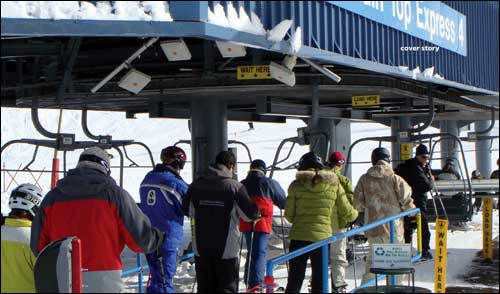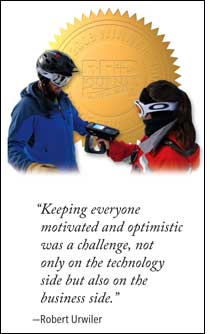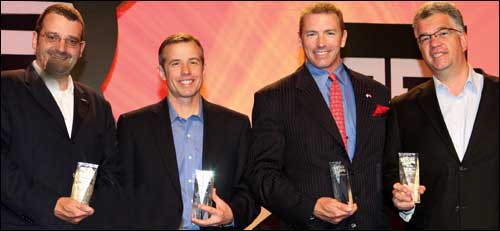On April 29, RFID Journal presented the third annual RFID Journal Awards to four companies for outstanding achievement in radio frequency identification technology at RFID Journal LIVE! 2009, the seventh annual conference and exhibition. The winners were:
• Charles Vögele Group for best RFID implementation
• Focus Magazine for most innovative use of RFID
• Vail Resorts for best use of RFID in a service
• ODIN Technologies for best in show

Best Use of RFID In a Service: Vail Resorts
When pass holders at Vail Resorts’ mountains hit the lift lines, they no longer have to fumble with gloves, jacket zippers or ski poles to get their identification cards ready for scanning. Instead, skiers and snowboarders can glide through the lines while an attendant using a handheld RFID interrogator reads their RFID-enabled passes, which can be safeguarded inside jackets or pockets.
The Easy Scan system, which replaces bar-coded lift passes, was rolled out at all five of Vail Resorts’ mountains last November, after two years of extensive planning and testing. It was designed to streamline lift access and improve the overall experience for the roughly 1.2 million skiers and snowboarders who flock to Vail’s mountains each year. Vail Resorts, a $1 billion publicly traded company based in Broomfield, Colo., operates five of the 10 busiest ski resorts in the United States: Beaver Creek, Breckenridge, Keystone and Vail in Colorado, and Heavenly, which straddles the border between California and Nevada.
“Customers love the new system,” says Robert Urwiler, the company’s chief information officer, and that’s important because season pass holders make up a growing portion of lift revenue for Vail Resorts. The RFID system also helps differentiate Vail Resorts’ properties from its competitors, Urwiler says. The company is realizing other benefits as well: The marketing department is using the data gathered from the tag reads at ski lift entry points, which provides information on how customers spend their time on the slopes, to target promotions. And the new validation process is helping to reduce season pass fraud.
RFID Lessons
Vail Resorts began looking into RFID technology three years ago, when it was time to replace the aging collection of bar-code scanners used to authenticate lift tickets and passes at the base of the mountains. Instead of simply upgrading the bar-code scanners, Vail opted to evaluate alternative technologies and processes to see if improvements could be made.
“We decided to crack the process open,” Urwiler says. Vail’s IT organization took the lead on the project and drew in representatives from lift operations, sales and other key departments in the company. The group evaluated several technologies, including bar code, biometric, and high-frequency (HF) and ultrahigh-frequency (UHF) RFID. Based on its stability and performance, the company decided to go with RFID. Vail then hired SkyeTek, a Westminster, Colo.-based RFID developer, to help evaluate different RFID products and advise on overall system design during the early stages of the project.
Vail decided to deploy UHF RFID, which is unusual for the ski industry. While RFID-embedded passes are common at European ski resorts and have started making inroads in the United States, such as at Aspen Mountain in Colorado and Alta Ski Area in Utah, those systems all operate in the HF range. Vail went with the UHF technology because of the longer read range that UHF offers. In addition, the HF systems use gates or turnstiles for access to the lifts, which Vail wanted to avoid. Grooming around the gates is difficult, flexibility is limited once the gates or turnstiles are installed, and the cost of building and maintaining them requires a steeper investment than the handheld and fixed-mount interrogators used in a UHF system, Urwiler says.
For several months, Vail conducted lab tests to evaluate RFID tags, interrogators and antennas. The team considered the various conditions that could affect tag reads, such as placement under several layers of clothing, interference from MP3 players and mobile phones, and the speed of the skier passing through the read zone. Next, the group conducted controlled field tests to validate the lab results in the real-world environment on the mountain. Based on the success of those tests, the company launched a pilot at Vail Mountain in late 2007 involving 1,000 ski patrol and ski school employees who were issued RFID-enabled passes. A year later, the system went live at all five of Vail’s mountains.
Here’s how the Easy Scan system works: RFID-enabled passes are read at two different points on the mountains. The first is when skiers or snowboarders are getting on the lifts at the base of the mountains. Armed with Intermec’s ruggedized CN3 handheld computer with a snap-on IP30 RFID reader and integrated bar-code scanner, an attendant stands at a distance of 1 to 2 feet from the guest and aims the reader at his or her mid-torso.
The unique identification number stored on the tag is sent via Wi-Fi to Vail’s Resort Management System, a customized version of Resort Technology Partners’ RPOS 5.5 software. The Resort Management System looks up the pass holder’s information in an SQL Server database and determines whether the identification number is valid. If it is, the software transmits a digital image of the pass holder along with personal information, such as birthday or home zip code, back to the handheld computer. The attendant then compares the digital picture with the pass holder. That process takes just a few seconds. If the person’s identity is in question, the attendant can use the personal information displayed on the handheld to ask a challenge question, such as “When is your birthday?”
The next tag read takes place farther up the slopes. Intermec‘s IF61 Enterprise RFID readers and antenna arrays are mounted on specialty lifts that take skiers and snowboarders to terrain parks, back bowls and other areas. As guests board the lifts, their tags are read without any direct interaction with employees. Unlike the handheld scanning process, in which only one tag is read at a time, the fixed-mount interrogators can read multiple tags simultaneously. The data from those reads, including tag identification number, date, time and location, is forwarded to the back-end database, which can later be mined to correlate with other data in the Resort Management System and the customer database.
Vail worked with Zebra Technologies on tag selection. It chose NXP’s G2XM RFID chips for the tags, and Zebra custom-designed the antenna inlay for optimal performance. Vail deployed more than 250 Zebra printer-encoders across the resorts, which, according to Urwiler, churned out “hundreds of thousands” of passes during this past ski season.
Hitting the Trials
Testing was extensive because the launch of the Easy Scan system would be so public—any snafus would impact hundreds of thousands of customers. “It was a disciplined approach,” Urwiler says. “People were sensitive to the guest experience. It had to be perfect.”
Throughout the pilot test, the team fine-tuned the technology to improve performance. For instance, at first they used an Intermec 751 handheld computer with an IP4 portable reader attached. But the handheld produced multiple tag reads due to the close proximity of skiers and snowboarders when they queue up to board the lifts. It was determined that the 751 handheld, which had circular polarization, added to the multiple tag reads. Vail decided to switch to the Intermec CN3 handheld with an IP30 reader attached, which had linear polarization. This greatly reduced the multiple tag readings. To further improve results, the application on the handheld was tweaked to filter multiple reads, using business rules to select the most relevant tag read.
A protective case was designed to shield the scanners from the unique weather conditions on the mountains—extreme cold, sun glare and moisture. Also, because a stylus is required for some applications, a tethered stylus that’s easy to use while wearing gloves was designed. And since battery life is shortened by exposure to extreme cold, Vail stocked up on extra batteries for the handhelds.
Achieving the necessary read rates with the mounted interrogators posed a different set of challenges. The read zone had to be configured to accommodate the various possible positions of skiers and snowboarders as they prepare to get on the lifts. To accomplish this, circular, polarized antennas were deployed and the RF signal strength was maximized. While the handheld interrogators achieve 100 percent read rates, the mounted readers are yielding read rates of about 89 percent—but that has exceeded expectations, Urwiler says.
A Team Effort
While Vail Resorts’ IT department coordinated and managed the Easy Scan development, several other departments were involved in bringing the project to life. For example, the lift operations staff designed the antenna mounting brackets for the fixed readers and coordinated the installation of the readers and antenna arrays. Scanning personnel contributed to product evaluation, field testing and development of the new scanning procedures.
The marketing department designed the new passes and RFID branding, developed all the Web and direct-mail communications to publicize the new system, and devised the fulfillment procedures for getting the passes into customers’ hands. Sales teams created the signs posted on the mountains to show guests the best way to wear the new passes—on the front of the upper body, preferably hung from a lanyard worn around the neck.
Vail also sought outside assistance from several vendors: Intermec helped optimize the equipment, and EMC’s Microsoft consulting practice designed the integration architecture and developed a custom data warehouse to store the tag data. Eric Simon, director of product sales and services at Vail Resorts, says input from the company’s operations staff early in the development process made an impact. “We whiteboarded the software from scratch,” he says, adding that Vail’s internal IT development team was able to incorporate many of the operations staff’s suggested features into the design.
Communication was imperative during the months of development and testing, Urwiler says. “Keeping everyone motivated and optimistic was a challenge, not only on the technology side but also on the business side,” he says. “When a field test would occasionally go poorly, we had to stress the iterative nature of the testing and refinement process.” Urwiler made sure to involve employees from across the company to build broad support for the project. “We had to draw the stakeholders in as active participants,” he says. “It’s easy to stand on the sidelines and complain. It’s different when you’re in the game.”
Declining to disclose the amount spent on the Easy Scan system, Urwiler says the company had no specific goals for return on investment. “This wasn’t sold as an ROI project,” he says. “It was sold as a strategic investment.” That investment seems to be paying off: Response from guests has been overwhelmingly positive, fraud detection is up by 100 percent at some mountains, and security has been strengthened while making it easier for pass holders to move through the lift lines. In addition, using the RFID data to gain insight into customer usage patterns, habits and preferences, Vail’s marketing department can shape promotional offers. For instance, if a pass holder spends a lot of time in the terrain park, information about special snowboarding events can be sent to that individual. As the amount of data collected increases, Vail expects to use the information to forecast trends and patterns for operations planning.
Vail Resorts says the season pass program is “fundamental” to its business model, because it insulates the company from the vicissitudes of economic and weather conditions. To improve the amenities for pass holders, Vail is considering expanding the use of RFID to other areas, such as parking validation and locker access. “As the tech continues to mature,” Urwiler says, “we’ll find other ways to use it.”
Other Winners
Click on the links below to read about the other 2009 RFID Journal Award winners:
• Charles Vögele Group for best RFID implementation
• Focus Magazine for most innovative use of RFID
• ODIN Technologies for best in show



